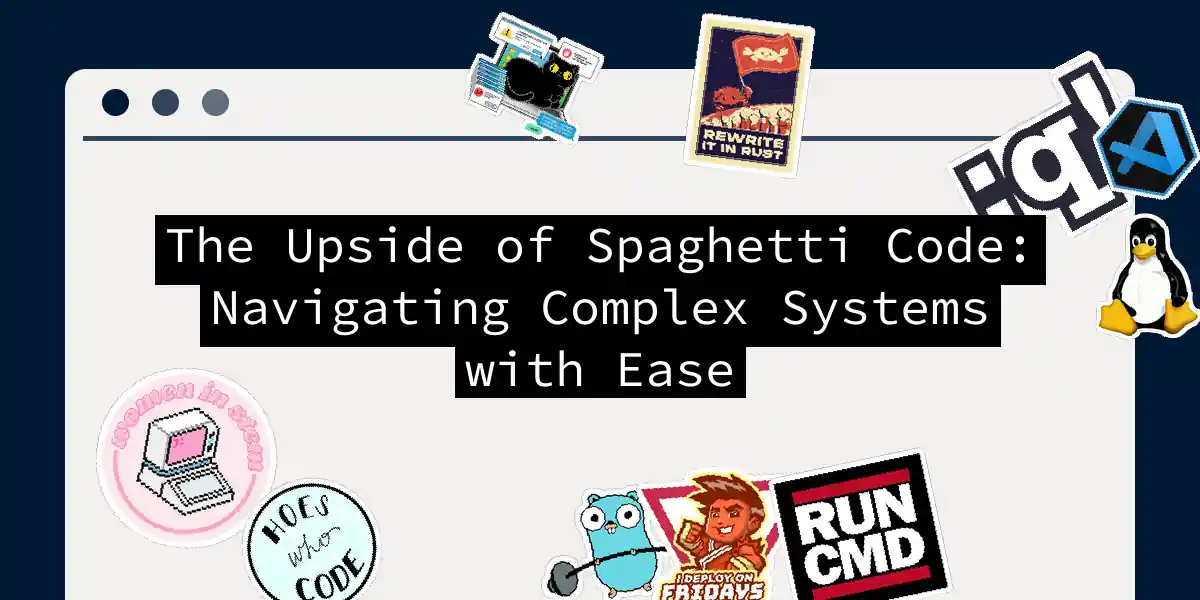Embracing the Beautiful Mess
We’ve all been there – staring at a codebase where function calls twist like fusilli, conditional statements loop like rigatoni, and class dependencies form a deliciously chaotic lasagna. While “spaghetti code” is universally maligned as a software anti-pattern, I’ve discovered unexpected advantages in these tangled code noodles when approached with the right mindset. After all, isn’t complexity just simplicity waiting to be understood? Let’s unpack why your plate of spaghetti might be more nutritious than you think.
Job Security Through Cryptic Brilliance
There’s a special kind of magic when you become the only developer who can navigate “Module X.” Your colleagues’ eyes glaze over as you deftly trace callback hell through seven layers of indirection – it’s your own private Hogwarts. This isn’t obfuscation; it’s job enrichment. When your CEO asks “How hard would it be to replace this system?” and your tech lead quietly slides you a retention bonus, you’ll thank those nested conditionals.
Creative Problem Solving Gym
Untangling spaghetti code is the CrossFit of cognitive training. Consider this Python snippet from a legacy inventory system:
def process_item(i):
if i.valid:
# 200 lines of nested conditionals
try: result = calculate(i, discount=(i.qty>10 and date.today().month==12))
except: result = 0 # Silent failures are features!
elif i.alternate:
return process_item(i.alternate) # Recursive spaghetti
# ... 15 more elif cases ...
Debugging this requires detective skills Sherlock would envy. Is it frustrating? Absolutely. But conquering it builds mental muscles no clean code project ever could.
The Pasta Theory of System Evolution
Spaghetti code often emerges from organic growth – like a city expanding without urban planning. The key is navigating it like a local instead of a frustrated tourist. Let’s visualize with a deliciously chaotic flow:
This emergent architecture has surprising benefits:
- Fault isolation: When everything’s connected, failures are contained – break one strand, the bowl holds
- Evolutionary resilience: Systems that resist compartmentalization often survive requirement shifts
- Behavioral archaeology: The code tells a story of business logic evolution
Navigation Toolkit: Taming Without Untangling
When refactoring isn’t an option, try these field-tested techniques: The Breadcrumb Trail Method
- Identify one meatball (core functionality)
- Insert trace statements:
console.log("🍝 Entering sauce_prep()") - Follow flow through 3 layers only
- Map relationships in a chaos notebook
- Repeat with adjacent meatballs
Documentation Espresso
Create “just-in-time” documentation:
## The Mystery of calculate_tax()
- Called from: order_processor.rb (line 147)
- Mutates: global_state.tax_cache
- Secret sauce: Only works on Tuesdays (legacy bug turned feature)
Strategic Apron Strings
When adding features:
- Wrap existing noodles:
new_feature()→spaghetti_adapter()→old_spaghetti() - Contain new code in modular containers
- Connect via clearly defined interfaces
When Spaghetti Saves the Day
During a critical outage last winter, our pristine microservices architecture collapsed like a soggy nacho chip while the “legacy spaghetti monster” – that Rube Goldberg machine we all mocked – hummed along processing orders. Why? Its very lack of boundaries created antifragility. While our elegant services failed at their API handshakes, the spaghetti’s tight coupling meant it either worked entirely or failed completely – no partial failure states. As Senior Engineer Bella Chen remarked: “It’s like that one dysfunctional family member who somehow always has jumper cables during a blizzard. You don’t question it – you just thank the code gods and move on.”
The Philosophical Meatball
At its core, spaghetti code is human nature manifested in digital form – complex, imperfect, and oddly beautiful. Before reaching for the refactoring ladle, consider:
- Does it actually need restructuring? (If it ain’t broke…)
- Does the business value justify the untangling cost?
- Could this apparent chaos actually be protecting us from worse architectural sins? So next time you encounter a plate of code spaghetti, grab a fork and dig in. You might discover:
- Hidden business rules preserved through layers
- Unexpected performance optimizations
- Brilliant workarounds for long-dead systems After all, in software as in life, sometimes the messiest systems have the most character. Now if you’ll excuse me, I have a date with a 2000-line function – wish me luck and pass the parmesan! 🧀
